
Flour is a powder made by grinding raw grains, roots, beans, nuts, or seeds. Flours are used to make many different foods. Cereal flour, particularly wheat flour, is the main ingredient of bread, which is a staple food for many cultures. Corn flour has been important in Mesoamerican cuisine since ancient times and remains a staple in the Americas. Rye flour is a constituent of bread in central and northern Europe.

Dundas is a city in Rice County, Minnesota, United States. The population was 1,367 at the 2010 census. Dundas is bordered by the city of Northfield. United States Army Major General Ulysses G. McAlexander was born in Dundas in 1864.

Saint Anthony Falls, or the Falls of Saint Anthony located at the northeastern edge of downtown Minneapolis, Minnesota, is the only natural major waterfall on the Mississippi River. Throughout the mid-to-late 1800’s, various dams were built atop the east and west faces of the falls to support the milling industry that spurred the growth of the city of Minneapolis. In 1880, the central face of the falls was reinforced with a sloping timber apron to stop the upstream erosion of the falls. In the 1950s, the apron was rebuilt with concrete, which makes up the most visible portion of the falls today. A series of locks were constructed in the 1950s and 1960s to extend navigation to points upstream.
Wheat flour is a powder made from the grinding of wheat used for human consumption. Wheat varieties are called "soft" or "weak" if gluten content is low, and are called "hard" or "strong" if they have high gluten content. Hard flour, or bread flour, is high in gluten, with 12% to 14% gluten content, and its dough has elastic toughness that holds its shape well once baked. Soft flour is comparatively low in gluten and thus results in a loaf with a finer, crumbly texture. Soft flour is usually divided into cake flour, which is the lowest in gluten, and pastry flour, which has slightly more gluten than cake flour.
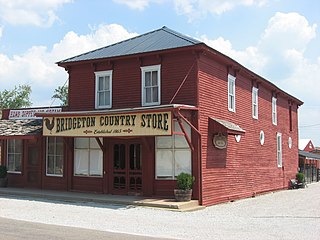
Bridgeton is an unincorporated community in Raccoon Township, Parke County, in the U.S. state of Indiana. It is notable for its covered bridge, which was destroyed on April 28, 2005, by a fire set by an arsonist. A historically accurate reconstruction of the bridge was completed in October, 2006.
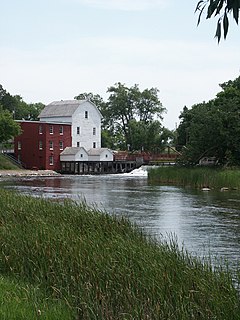
Phelps Mill is a flour mill in Otter Tail County, Minnesota, United States, on the Otter Tail River. The mill was built in 1888–1889 by William E. Thomas, a local entrepreneur who owned a flour and feed business in Fergus Falls. During that time, wheat was a high-demand crop, and nearly one thousand flour mills were in operation throughout Minnesota. Thomas began constructing a wooden dam on the river in the spring of 1888, although the dam was prone to leakage and had to be shored up with sandbags, dirt, gravel, and other materials. The mill itself was built by Royal Powers, who built and framed the mill without using blueprints. He was able to keep the entire plan within his head and did not even have to mark out the lumber he was cutting.

Minneapolis is the largest city by population in the U.S. state of Minnesota, and the county seat of Hennepin County. The origin and growth of the city was spurred by the proximity of Fort Snelling, the first major United States military presence in the area, and by its location on Saint Anthony Falls, which provided power for sawmills and flour mills.
A middlings purifier is a device used in the production of flour to remove the husks from the kernels of wheat. It was developed in Minnesota by Edmund LaCroix, a French inventor hired by Cadwallader C. Washburn and George Christian of the Washburn "A" Mill. It was developed to complement the emerging roller mill teJOSIEchnique of the late 19th century, which used corrugated metal rollers instead of abrasive grindstones to grind wheat into flour. The middlings purifier was used to separate the bran from the usable part of the flour. The machine developed by LaCroix passed the partially ground middlings over a screen, and a stream of air blew away the particles of bran.
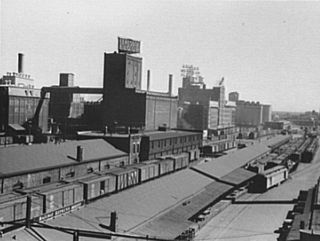
Northwestern Consolidated Milling Company was an American flour milling company that operated about one quarter of the mills in Minneapolis when the city was the flour milling capital of the world. Formed as a business entity, Northwestern produced flour for the half century between 1891 and 1953, when its A Mill was converted to storage and light manufacturing. At its founding, Northwestern was the city's and the world's second largest flour milling company after Pillsbury, with what is today General Mills a close third. The company was touched by an attempt at U.S. monopoly and became part of a Minneapolis oligopoly that valued in 1905 owned almost 9% of the country's flour and grist products.

Swany White Flour Mills is a flour manufacturing and wholesaling company based in Freeport, Minnesota, United States. It was established in the late 19th century and has been owned by the same family since 1903. On December 27, 2011, the company's historic 114-year-old mill burned down. Construction on a new facility began the following summer, and Swany White Flour Mills was able to remain in business.

Schech's Mill is a historic mill in Houston County, Minnesota, United States. It is one of three watermills in Minnesota still operating solely with water power and the only one to have its original millstones. Built by John Blinn in 1876, it was purchased by a Minneapolis miller, Michael Schech who had emigrated from Bavaria, Germany. The mill produced cornmeal, rye buckwheat, wheat flour, graham flour, and whole wheat cereal, which was sold in Caledonia and Houston, Minnesota. Schech's Mill is unique in the state for retaining intact and operable machinery from the 1870s, after the middlings purifier had been introduced but before millstones were supplanted by roller mills. In 1922, a concrete dam was built to replace the original wooden one.

The Archibald Mill was a water-powered gristmill complex, now reduced to ruins, on the Cannon River in Dundas, Minnesota, United States. The mill was founded in 1857 and expanded with a second mill across the river in 1870. It was the first U.S. mill to produce and market patent flour, and its "Dundas Straight" was once considered the best flour in the country. The Archibald Mill is associated with the introduction of hard spring wheat to Minnesota, and was one of the nation's first outfits to convert fully into a roller mill. The site is listed on the National Register of Historic Places for its national significance in commerce, industry, and flour milling.

Mill City Museum is a Minnesota Historical Society museum in Minneapolis. It opened in 2003 built in the ruins of the Washburn "A" Mill next to Mill Ruins Park on the banks of the Mississippi River. The museum focuses on the founding and growth of Minneapolis, especially flour milling and the other industries that used hydropower from Saint Anthony Falls.
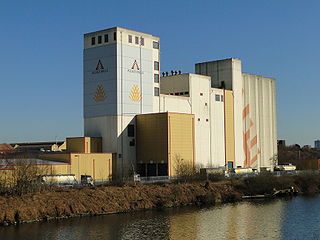
A gristmill grinds cereal grain into flour and middlings. The term can refer to either the grinding mechanism or the building that holds it. Grist is grain that has been separated from its chaff in preparation for grinding.
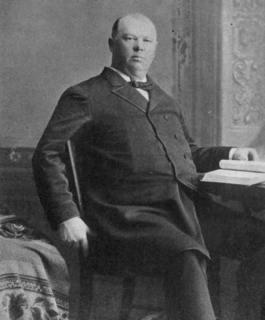
John Stevens was a miller and inventor who lived in Neenah, Wisconsin. His inventions in flour milling revolutionized the process, leading to large-scale shifts in wheat-growing regions, and to the predominance of particular milling companies and mill-equipment manufacturers. Today Patent flour is still referred to due to Stevens' patents.

Hodgson-Aid Mill, also known as Hodgson Water Mill and Aid-Hodgson Mill, is a historic grist mill located on Bryant Creek near Sycamore, Ozark County, Missouri. It was constructed around 1897, and is a 3+1⁄2-story, timber frame mill building covered with red-painted weatherboards. Associated with the mill are the man-made mill pond and the limestone barrel vault constructed at the base of the cliff where Hodgson Spring discharges. The mill has not been in operation since 1976. It is privately owned.
The Roller Mill was created by Hungarian bakers in the late 1860s and its popularity spread worldwide throughout the 1900s. Roller mills now produce almost all non-whole grain flour. Enriched flour is flour that meets an FDA standard in the United States. Roller milled white enriched flour makes up over 90% of the flour that comes out of the United States.

Lehi Roller Mills is a locally run and operated flour mill and historical landmark of Lehi, Utah. The original brick building was built in 1905 and has expanded since then. It has become an iconic feature of the Utah Valley as a filming location for Footloose (1984). The Roller Mills was added to the National Register of Historic Places in 1994. The building still stands today and is home to a renovated business model now named ‘Lehi Mills’.
Ames Mill Dam is a 6-foot (2 m) low-head dam located near South Water Street in Northfield city, in southeastern Minnesota, in the United States. It lies on the Cannon River, a tributary of the Mississippi River 35 miles (55 km) south of St. Paul. Ames Mill was originally built as a wooden dam in 1855 and then rebuilt as one of the six concrete dams on the Cannon River in 1919. The Cannon River was central to industrial development in the late 19th century through hydroelectric power production. The presence of dams along the river has influenced geomorphologic changes which affect fish, mussel populations and sediment. The Ames Mill Dam was used to power the Ames Flour Mill; however, it is no longer used for hydroelectric power because the dam is old and nearing the end of its lifespan. Currently the dam serves no functional purpose. The Cannon River is an essential part of Northfield's economic community and the Ames Mill Dam is a part of Northfield’s historic identity. The dam is currently owned by Malt-O-Meal, a breakfast cereal company founded in 1919 and headquartered in Northfield, Minnesota.



















